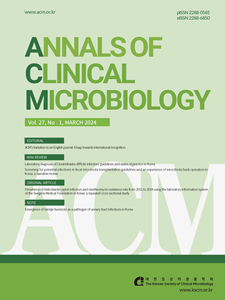Seasonality and epidemiological trends in species distribution and antifungal susceptibility of Candida species isolated from various clinical specimens conducted during 2011–2022, Korea: a retrospective surveillance study
Original article Seo Young Hwang, Young Kwan Lim, Kye Won Choe, Young ho Choi, Mi-Kyung Lee Department of Laboratory Medicine, Chung-Ang University College of Medicine, Seoul, Korea Corresponding to Mi-Kyung Lee, E-mail: cpworld@cau.ac.kr Ann Clin Microbiol 2024;27(3):185-196. https://doi.org/10.5145/ACM.2024.27.3.6Received on 2 February 2024, Revised on 8 September 2024, Accepted on 9 September 2024, Published on 20 September 2024.Copyright © Korean Society of Clinical Microbiology.This is an Open Access article which is freely available under the Creative Commons Attribution-NonCommercial-NoDerivatives 4.0 International License (CC BY-NC-ND) (https://creativecommons.org/licenses/by-nc-nd/4.0/). Abstract Background: As most Candida species cause opportunistic infections, it is helpful for patient care to determine species name of Candida spp. and their distribution in both sterile and non-sterile specimens. We aimed to investigate trends in the distribution of Candida species isolated from a hospital in Korea, along with their antifungal susceptibilities and seasonal variations. Methods: This study was conducted at the Chung-Ang University Hospital and included 8,760 different clinical specimens from


